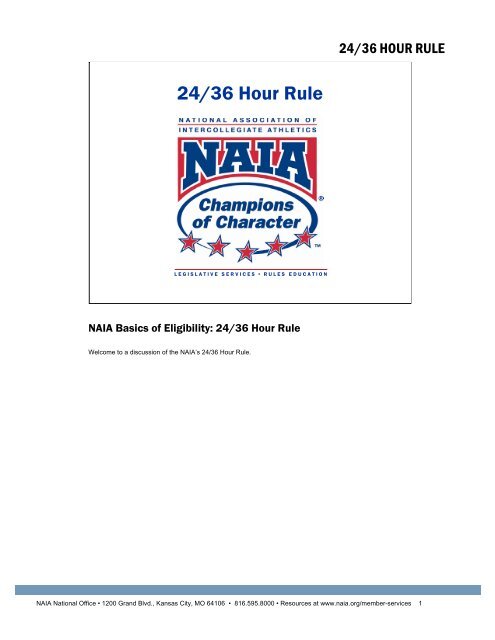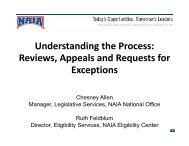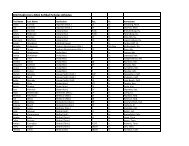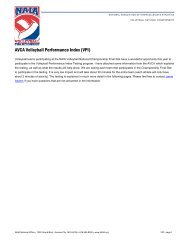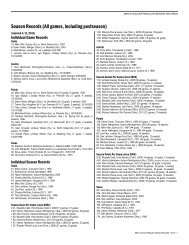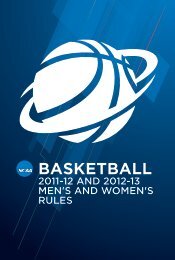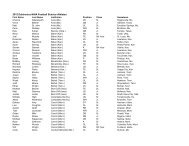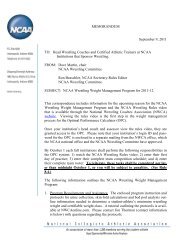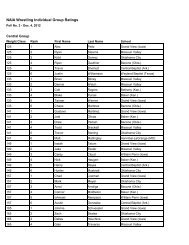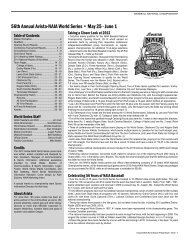24/36 Hour Rule - NAIA
24/36 Hour Rule - NAIA
24/36 Hour Rule - NAIA
You also want an ePaper? Increase the reach of your titles
YUMPU automatically turns print PDFs into web optimized ePapers that Google loves.
<strong>24</strong>/<strong>36</strong> <strong>Hour</strong> <strong>Rule</strong><br />
L E G I S L A T I V E S E R V I C E S • R U L E S E D U C A T I O N<br />
<strong>NAIA</strong> Basics of Eligibility: <strong>24</strong>/<strong>36</strong> <strong>Hour</strong> <strong>Rule</strong><br />
Welcome to a discussion of the <strong>NAIA</strong>’s <strong>24</strong>/<strong>36</strong> <strong>Hour</strong> <strong>Rule</strong>.<br />
<strong>24</strong>/<strong>36</strong> HOUR RULE<br />
<strong>NAIA</strong> National Office • 1200 Grand Blvd., Kansas City, MO 64106 • 816.595.8000 • Resources at www.naia.org/member-services 1
If a student …<br />
Competes in a contest<br />
Is enrolled in 12 hours and attends one<br />
class while being enrolled in 12 hours<br />
Identification<br />
Ways a student identifies with your institution.<br />
<strong>24</strong>/<strong>36</strong> HOUR RULE<br />
Charged with season<br />
Charged with term<br />
Charged with term<br />
This rule applies to students once they have been enrolled in your institution or any collegiate institution for two terms, whether it’s<br />
two semesters, two quarters or two trimesters.<br />
Before we go any further, we need to discuss which academic terms must be counted. In the <strong>NAIA</strong>, terms are countable when a<br />
student “identifies” during a term. There are two ways for a student to identify. The first is by playing in a contest against another<br />
team. Regardless of anything else, if the student plays in a contest representing an institution against another team, the student has<br />
identified.<br />
The second way a student can identify is by being enrolled in 12 hours and attending one class. Again, if the student enrolls in 12<br />
hours and attends one class, the student has identified. No subsequent action by the student or the institution can change<br />
identification. This is true even if the student withdraws from all courses the day after attending class and that institution’s transcript<br />
does not show the student enrolled during that term. This makes it very important for you to interview the student carefully when the<br />
student fills out the transfer form and the competitive experience form.<br />
Once the student has identified during two terms, the student must have <strong>24</strong> hours to be eligible. If we are talking about quarter<br />
institutions, once the student has been enrolled for three quarters, the student is going to be responsible for having earned <strong>36</strong> hours<br />
going forward. The other important thing to remember, and this is true with all <strong>NAIA</strong> eligibility rules, is that we certify on aterm-by term basis, which means this is a rolling <strong>24</strong>/<strong>36</strong> hours.<br />
The way this rule works is that you look at the student’s previous two terms or previous three quarters to determine whether the<br />
student has earned the requisite hours. I am going to use semester hours as an example, but the same rules apply for a student in<br />
the quarter system.<br />
<strong>NAIA</strong> National Office • 1200 Grand Blvd., Kansas City, MO 64106 • 816.595.8000 • Resources at www.naia.org/member-services 2
4th<br />
academic<br />
year<br />
3rd<br />
academic<br />
year<br />
2nd<br />
academic<br />
year<br />
1st<br />
academic<br />
year<br />
Certify for Fall 2009<br />
12<br />
hours<br />
earned<br />
Continuing Eligibility<br />
<strong>24</strong>/<strong>36</strong> hour rule<br />
28<br />
hours<br />
4 hours Summer 2009<br />
<strong>24</strong>/<strong>36</strong> HOUR RULE<br />
<strong>NAIA</strong> National Office • 1200 Grand Blvd., Kansas City, MO 64106 • 816.595.8000 • Resources at www.naia.org/member-services 3<br />
12<br />
Fall 2008 Spring 2009<br />
hours<br />
earned<br />
To compete, must have <strong>24</strong> hours during the student’s previous two terms or<br />
<strong>36</strong> hours during the student’s previous three quarters.<br />
If you are certifying a student in the fall of 2009 and the student has been a continuous student, you would look<br />
back at spring of 2009 and fall of 2008 and count the number of hours earned to determine whether the student<br />
has met the <strong>24</strong> hour rule. You can include the immediate previous summer in this example. The student must<br />
have earned <strong>24</strong> hours total during the previous fall and spring. As you can see in this example, the student<br />
earned 28 hours.
4th<br />
academic<br />
year<br />
3rd<br />
academic<br />
year<br />
2nd<br />
academic<br />
year<br />
1st<br />
academic<br />
year<br />
8<br />
hours<br />
earned<br />
12 hours enrolled<br />
12<br />
hours<br />
earned<br />
Fall 2009<br />
Continuing Eligibility<br />
<strong>24</strong>/<strong>36</strong> hour rule<br />
4 hours Summer 2009<br />
<strong>24</strong>/<strong>36</strong> HOUR RULE<br />
Certify for Spring 2010 <strong>24</strong><br />
hours<br />
<strong>NAIA</strong> National Office • 1200 Grand Blvd., Kansas City, MO 64106 • 816.595.8000 • Resources at www.naia.org/member-services 4<br />
12<br />
Fall 2008 Spring 2009<br />
hours<br />
earned<br />
To compete, must have <strong>24</strong> hours during the student’s previous two terms or<br />
<strong>36</strong> hours during the student’s previous three quarters.<br />
When you go to certify the student in the spring 2010, you would look at the fall just completed and the<br />
previous spring. Look at any summer hours the student would have earned during that intervening time.<br />
In this example, the student earned credit for eight of the 12 enrolled in Fall, 12 hours in previous spring, plus<br />
the four summer hours for <strong>24</strong> total.
4th<br />
academic<br />
year<br />
3rd<br />
academic<br />
year<br />
2nd<br />
academic<br />
year<br />
1st<br />
academic<br />
year<br />
Certify for Fall 2010<br />
8<br />
hours<br />
earned<br />
12 hours enrolled<br />
12<br />
hours<br />
earned<br />
Fall 2009<br />
Continuing Eligibility<br />
<strong>24</strong>/<strong>36</strong> hour rule<br />
4 hours Summer 2009<br />
<strong>24</strong>/<strong>36</strong> HOUR RULE<br />
<strong>NAIA</strong> National Office • 1200 Grand Blvd., Kansas City, MO 64106 • 816.595.8000 • Resources at www.naia.org/member-services 5<br />
22<br />
hours<br />
2 hours Summer 2010<br />
12<br />
hours<br />
earned<br />
12<br />
Spring 2010<br />
Fall 2008 Spring 2009<br />
hours<br />
earned<br />
To compete, must have <strong>24</strong> hours during the student’s previous two terms or<br />
<strong>36</strong> hours during the student’s previous three quarters.<br />
Moving forward to Fall 2010, this example shows the student’s 12 hours in spring 2010 with the eight earned in<br />
Fall 2009 plus the two summer hours. This does not add up to the <strong>24</strong> required.<br />
In each of these examples, you’ll note that it possible for the student to earn hours during summer terms or inter<br />
terms to meet the requirements of the <strong>24</strong>-hour rule, but the student is limited to 12 hours during summer or other<br />
non-terms. Other than summer, the only other non-terms you can have are when a student enrolls in less than<br />
12 hours during a term or when a student earns hours during an inter-term and the student needs those hours<br />
to be eligible. Again, the student is limited to 12 non-term hours.<br />
Remember, the <strong>24</strong>/<strong>36</strong> hour rule is a snapshot of the previous two terms. You can’t bank hours two years ago to<br />
get you through this now. This is why in these examples, hours outside of the two previous terms are grayed<br />
out, they can’t be used. You have to have earned <strong>24</strong> hours during your previous two semesters.
Continuing Eligibility<br />
<strong>24</strong>/<strong>36</strong> Exceptions<br />
• Student participation and withdrawal from institution prior to start of<br />
academic term. (Note: Progress <strong>Rule</strong> still applies)<br />
• Junior College transfer who needed less than <strong>24</strong> hours during last two<br />
semesters to get associate’s degree:<br />
– Identified in no more than five semesters<br />
– Passed all hours during term in which degree was earned<br />
• First term of collegiate competition:<br />
– If in first four semesters - Must meet freshman eligibility rules<br />
– If in semesters five and above – 2.0 GPA in all courses<br />
attempted at all institutions.<br />
<strong>24</strong>/<strong>36</strong> HOUR RULE<br />
There are three exceptions to the <strong>24</strong>/<strong>36</strong> hour rule. The first two are not used as often as the third exception, but let’s review all three.<br />
The first exception occurs when a student participates prior to the start of a term, but then withdraws from the institution prior to the start of<br />
the term. In this case, you do not have to use the term in determining whether the student meets the <strong>24</strong>/<strong>36</strong> hour rule. Please note that this<br />
still counts as a season of competition for the student and this participation will affect the student’s requirements in regards to the progress<br />
rule.<br />
The second exception is for students transferring to your institution from a two-year college. If the student needed less than <strong>24</strong> hours during<br />
the last two terms to get an associate’s degree, the student may be eligible for this exception. There are a few conditions. First, the student<br />
must not have identified in more than five semesters prior to the term in which you wish to certify the student. Second, the student must have<br />
passed all hours during the term in which the degree was awarded. If the student meets all of these requirements, the student does not have<br />
to meet the <strong>24</strong>/<strong>36</strong> hour rule. In order for this student to use the exception after the first term at your institution, the student pass at least 12<br />
hours in his/her first term at your institution.<br />
Finally, the most common exception to this rule is available to students who have not competed previously in any sport at any collegiate<br />
institution. The student is exempted from the <strong>24</strong>/<strong>36</strong> hour rule if she or he meets the following conditions. A student who is in his/her first four<br />
semesters or six quarters can use the exception provided the student met <strong>NAIA</strong> freshman eligibility standards. If the student is in semester<br />
five or quarter seven or above, the student must have a collegiate GPA of 2.0 on a 4.0 scale. The GPA must be calculated on the basis of all<br />
transcripts from all institutions the student has attended.<br />
Again, the <strong>24</strong>-hour rule is a simple rule, but one that prevents many students from participating. If a student has a poor academic term, it is<br />
important that you advise the student to make up any deficiency before the next certification period.<br />
<strong>NAIA</strong> National Office • 1200 Grand Blvd., Kansas City, MO 64106 • 816.595.8000 • Resources at www.naia.org/member-services 6


